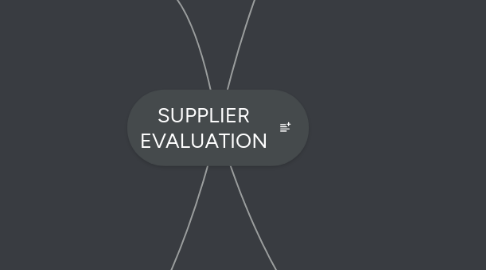
1. Criteria of Supplier Evaluation
1.1. MEASUREMENT
1.1.1. Quantitative
1.1.2. Qualitative
1.2. INDICATORS
1.2.1. Lagging indicators
1.2.2. Leading indicators
1.3. APPROACH
1.3.1. Reactive approach
1.3.2. Proactive approach
2. Goals of supplier evaluation
2.1. Benefits of Supplier Evaluation
2.1.1. Increase performance visibility
2.1.2. Uncover and remove hidden waste and cost drivers in the supply chain
2.1.3. Leverage the supply base
2.1.4. Align customer and supplier business practices
2.1.5. Mitigate risk
2.1.6. Improve supplier performance
3. Evaluation approaches
3.1. SURVEY AND QUESTIONAIRES
3.1.1. Barriers/Challenges
3.1.1.1. Requires knowledge of what to measure • Hard to construct sound survey instruments • Difficult to deploy • Relevance of results • Not always actionable • Supplier compliance issues
3.1.2. Types of survey
3.1.2.1. RFD surveys
3.1.2.2. Quality surveys
3.1.2.3. Supplier surveys
3.2. SCORECARDS
3.2.1. Barriers/challenges
3.2.1.1. • Data integrity • Requires resources for cleansing, massaging, formatting • Disputes with suppliers over data integrity • Not clearly actionable • Do not identify root cause
3.3. SUPPLIER ASSESSMENT
3.3.1. Types of assessment
3.3.1.1. Subjective methods
3.3.1.2. Objective methods
3.3.2. Levels of assessment
3.3.2.1. Product level
3.3.2.2. Process level
3.3.2.3. Quality assurance system level
3.3.2.4. Company level
3.4. SUPPLIER AUDIT
3.5. SITE VISIT
3.5.1. Barrier/challenges
3.5.1.1. Resource intensive • Requires trained personnel • Site visit instrument & expertise • Can be inconsistent • Hard to scale the process
4. Evaluation Strategy
4.1. SGEMENTING THE SUPPLY BASE
4.1.1. Procurement Porfolio
4.1.1.1. Strategic supplier
4.1.1.2. Leverage supplier
4.1.1.3. Bottleneck supplier
4.1.1.4. Nocritical supplier
4.1.2. Supplier commitment matrix
4.1.3. Supplier characterization matrix
4.2. DIFFERENT ACTIONS FOR DIFFERENT SEGMENTS
4.2.1. Supplier Action Management matrix
4.2.2. Segmentation for supplier performance management actions
